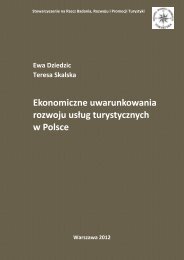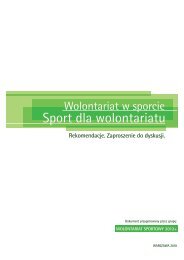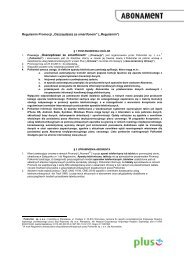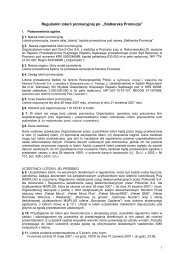Korytarz ekologiczny doliny Odry pdf
Korytarz ekologiczny doliny Odry pdf
Korytarz ekologiczny doliny Odry pdf
You also want an ePaper? Increase the reach of your titles
YUMPU automatically turns print PDFs into web optimized ePapers that Google loves.
<strong>Korytarz</strong> <strong>ekologiczny</strong> <strong>doliny</strong> <strong>Odry</strong><br />
• the use of only biological substances for combatting pests,<br />
• the preservation of hollowed trees.<br />
3. The enlargement of isolated patches of forest is recommended.<br />
4. The areas of the valley with peatbogs and other valuable wetlands, as well as scarps<br />
with xerothermic vegetation, should not be reforested.<br />
5. Seed material used for forest restoration should be of native origin.<br />
6. Alien tree species should be strictly avoided.<br />
Flood protection<br />
The narrow approach to the problems of flood protection of the Oder river should hence<br />
forth be abandoned. The cutting of trees and shrubs must not be the only solution. Flood hazards<br />
occur in the entire catchment basin, so that preventive activities should be undertaken<br />
there and not only in the Oder valley. The following measures have been recommended:<br />
1. Resignation from the construction of new levees, in particular levees situated close to<br />
the rivers and moving the existing levees away from the rivers. This will increase a valley<br />
retention, which lowers the danger of flood in lower stretches of the river. There will be<br />
enough space in the wide area between levees for the development of shrubs and trees,<br />
which will enhance biological and landscape diversity, slow down the run-off of water from<br />
the area of the country and change the management of the area between the levees.<br />
2. Construction of local depressions and culverts in the levees in order to increase the<br />
valley retention and irrigate the area outside the levees.<br />
3. Construction of additional flood polders in the Oder valley and in the valleys of its<br />
tributaries, particularly in the areas requiring high moisture. This can be done by building<br />
embankments around peatbogs and other wetlands as well as riverside carrs. The use of polders<br />
for the restoration of typical fauna and flora to floodplains is a good example of compromising<br />
flood control and nature conservation interests.<br />
4. The creation of floodplains in the zones surrounding the mouths of the Oder tributaries,<br />
similar to those at the mouth of the Warta into the Oder. For this reason, the existing<br />
levees occurring along those parts of the Oder tributaries should be moved away.<br />
5. The reconstruction of small retention reservoirs on the Oder tributaries (see below).<br />
6. The construction of relief channels, on the stretches posing a flood hazard.<br />
7. An increase in soil retention of the Oder valley and its catchment area through afforestation,<br />
proper agro-technical practices (long-lasting vegetational cover), increase of the<br />
organic matter contents of the soil, and anti-erosion activities, etc.<br />
Restructuring of the Oder river bed, hydrotechnical facilities, and navigation<br />
development<br />
It is proposed to resign from the projects focused on the extension and reconstruction of<br />
the Oder river bed so that to improve its navigational conditions, its adaptation to larger<br />
220



![PENTAGRAM Cerberus [P 6367] Installation and Operation Manual](https://img.yumpu.com/49786948/1/184x260/pentagram-cerberus-p-6367-installation-and-operation-manual.jpg?quality=85)
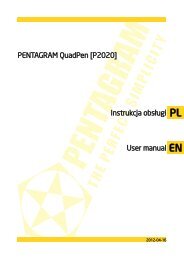
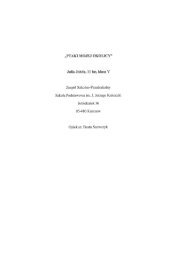

![PENTAGRAM Cerberus [P 6361] Quick Guide](https://img.yumpu.com/43449286/1/185x260/pentagram-cerberus-p-6361-quick-guide.jpg?quality=85)

